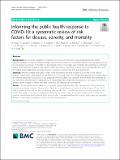Informing the public health response to COVID-19 : a systematic review of risk factors for disease, severity, and mortality
Abstract
Background Severe Acute Respiratory Syndrome coronavirus-2 (SARS-CoV-2) has challenged public health agencies globally. In order to effectively target government responses, it is critical to identify the individuals most at risk of coronavirus disease-19 (COVID-19), developing severe clinical signs, and mortality. We undertook a systematic review of the literature to present the current status of scientific knowledge in these areas and describe the need for unified global approaches, moving forwards, as well as lessons learnt for future pandemics. Methods Medline, Embase and Global Health were searched to the end of April 2020, as well as the Web of Science. Search terms were specific to the SARS-CoV-2 virus and COVID-19. Comparative studies of risk factors from any setting, population group and in any language were included. Titles, abstracts and full texts were screened by two reviewers and extracted in duplicate into a standardised form. Data were extracted on risk factors for COVID-19 disease, severe disease, or death and were narratively and descriptively synthesised. Results One thousand two hundred and thirty-eight papers were identified post-deduplication. Thirty-three met our inclusion criteria, of which 26 were from China. Six assessed the risk of contracting the disease, 20 the risk of having severe disease and ten the risk of dying. Age, gender and co-morbidities were commonly assessed as risk factors. The weight of evidence showed increasing age to be associated with severe disease and mortality, and general comorbidities with mortality. Only seven studies presented multivariable analyses and power was generally limited. A wide range of definitions were used for disease severity. Conclusions The volume of literature generated in the short time since the appearance of SARS-CoV-2 has been considerable. Many studies have sought to document the risk factors for COVID-19 disease, disease severity and mortality; age was the only risk factor based on robust studies and with a consistent body of evidence. Mechanistic studies are required to understand why age is such an important risk factor. At the start of pandemics, large, standardised, studies that use multivariable analyses are urgently needed so that the populations most at risk can be rapidly protected.
Citation
Flook , M , Jackson , C , Vasileiou , E , Simpson , C R , Muckian , M D , Agrawal , U , McCowan , C , Jia , Y , Murray , J , Ritchie , L D , Robertson , C , Stock , S J , Wang , X , Woolhouse , M E J , Sheikh , A & Stagg , H R 2021 , ' Informing the public health response to COVID-19 : a systematic review of risk factors for disease, severity, and mortality ' , BMC Infectious Diseases , vol. 21 , 342 . https://doi.org/10.1186/s12879-021-05992-1
Publication
BMC Infectious Diseases
Status
Peer reviewed
ISSN
1471-2334Type
Journal article
Description
Funding: HRS and MF are supported by the Medical Research Council [MR/R008345/1]. CJ’s salary came through MRC core funding MC_UU_12023/26. SJS is funded by the Wellcome Trust [WT 209560/Z/17/Z]. CRS has received funding from the Medical Research Council [MR/R008345/1], the National Institute for Health Research [11/46/23] and the New Zealand Health Research Council [20/1018] and Ministry for Business, Innovation and Employment. EV is funded by the Medical Research Council [MR/R008345/1] through the EAVE II grant and supported by the Scottish Government. We also acknowledge the support of HDR UK. The views and opinions expressed here are those of the authors and do not necessarily reflect those of the Health Technology Assessment programme, NIHR, NHS, or the UK Department of Health.Collections
Items in the St Andrews Research Repository are protected by copyright, with all rights reserved, unless otherwise indicated.

